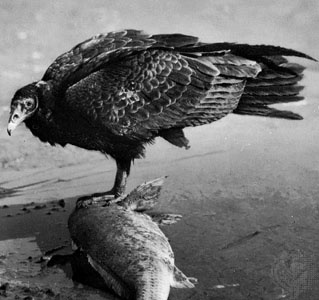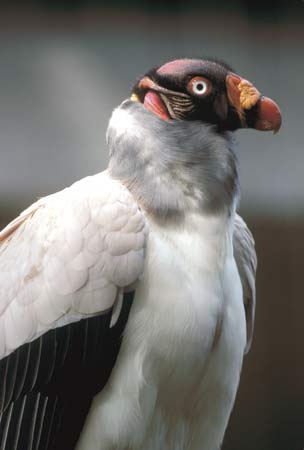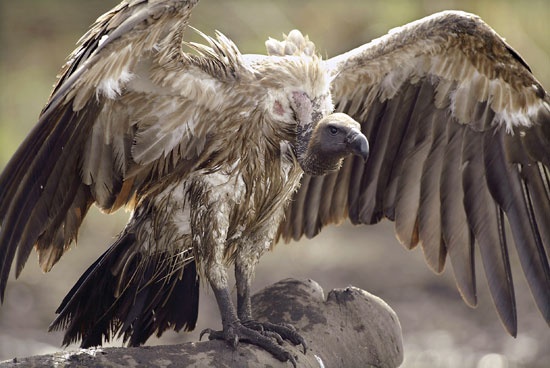vulture
bird
Introduction
 any of 22 species of large, carrion-eating birds that live predominantly in the tropics and subtropics. The seven species of New World vultures include condors, and the 15 Old World species include the lammergeier and griffons. Although many members of the two groups appear similar, they are only distantly related.
any of 22 species of large, carrion-eating birds that live predominantly in the tropics and subtropics. The seven species of New World vultures include condors, and the 15 Old World species include the lammergeier and griffons. Although many members of the two groups appear similar, they are only distantly related.All of the New World vultures and some of the Old World vultures have bare heads, a condition that prevents feathers from matting with blood when the birds reach inside carcasses. Most vultures have a large pouch in the throat (crop) and can go for long periods without food—adaptations to a feast-or-famine scavenging lifestyle. In some species the beak is exceptionally strong and heavy for tearing hide, muscle, and even bone. Eyesight in all vultures is well developed, as is the sense of smell in the turkey vulture. Old World vultures have relatively strong feet, but New World Vultures have flat, weak feet that are poorly adapted for grasping.
Vultures are widely distributed, but they are absent from Australia and most oceanic islands. Most have broad food habits, consuming carrion, garbage, and even excrement, but rarely do they descend upon live animals. A few occasionally take helpless prey such as lambs and tortoises or, in the case of Andean condors, newborn calves. Vultures may remain aloft for hours, soaring gracefully on long, broad wings. When one bird descends to a dead or dying animal, others may be attracted from miles away. When feeding, vultures maintain a strict social order based on body size and strength of beak. Smaller vultures must wait for the scraps left behind by the larger, dominant species. Even large vultures, however, give way to nearly all mammalian competitors, including jackals, hyenas, and coyotes.
Most vultures inhabit open country, often roosting in groups on cliffs, in tall trees, or on the ground. Old World vultures build large stick platform nests in trees or on cliffs, sometimes in large colonies. Most of the larger Old World vultures lay only a single egg. New World vultures do not build nests but lay their eggs in bare scrapes in natural cavities in cliffs or trees; none nests colonially. The smaller New World vultures lay two eggs and incubate them for just over a month. The largest species lay only a single egg that may take nearly two months to hatch. The young mature more slowly than those of typical birds of prey. New World vultures have no voice because they lack a syrinx; they have a perforated nasal septum.
New World vultures
 The turkey vulture (Cathartes aura) is the most widespread New World vulture, breeding from Canada southward to the southern tip of South America. Northern populations are migratory. They are small brownish black vultures with red heads as adults (dark gray as juveniles) and a wingspan of nearly 2 metres (6.6 feet). They are usually the first to find carcasses, owing to their well-developed sense of smell, but they are more timid than other vultures and retreat while other species feed.
The turkey vulture (Cathartes aura) is the most widespread New World vulture, breeding from Canada southward to the southern tip of South America. Northern populations are migratory. They are small brownish black vultures with red heads as adults (dark gray as juveniles) and a wingspan of nearly 2 metres (6.6 feet). They are usually the first to find carcasses, owing to their well-developed sense of smell, but they are more timid than other vultures and retreat while other species feed. In addition to the California and Andean condors, other notable New World vultures include the black vulture (Coragyps atratus), a New World vulture sometimes called a black buzzard or, inappropriately, a carrion crow. The black vulture, the most abundant vulture species of all, is a resident of the tropics and subtropics that often wanders far into temperate regions. It is a chunky black bird about 60 cm (24 inches) long, with a very short tail, short wings, a bare black head, and a feathered hindneck.
In addition to the California and Andean condors, other notable New World vultures include the black vulture (Coragyps atratus), a New World vulture sometimes called a black buzzard or, inappropriately, a carrion crow. The black vulture, the most abundant vulture species of all, is a resident of the tropics and subtropics that often wanders far into temperate regions. It is a chunky black bird about 60 cm (24 inches) long, with a very short tail, short wings, a bare black head, and a feathered hindneck. The king vulture (Sarcoramphus papa) is the most colourful vulture. The head and neck are red, yellow, and bluish; the eyes are white with red eye-rings; the body is buff above and white below; and the neck fringe is gray. Wingspan is about 2 metres; the body is about 80 cm (31 inches) long. King vultures range from southern Mexico to Argentina, where they soar singly or in pairs over tropical forest (tropical rainforest)s.
The king vulture (Sarcoramphus papa) is the most colourful vulture. The head and neck are red, yellow, and bluish; the eyes are white with red eye-rings; the body is buff above and white below; and the neck fringe is gray. Wingspan is about 2 metres; the body is about 80 cm (31 inches) long. King vultures range from southern Mexico to Argentina, where they soar singly or in pairs over tropical forest (tropical rainforest)s.New World vultures are generally classified with storks in the order Ciconiiformes (ciconiiform).
Old World vultures
 The cinereous vulture, sometimes called the black vulture (Aegypius monachus), is one of the largest flying birds. It is about 1 metre (3.3 feet) long and 12.5 kg (27.5 pounds) in weight, with a wingspan of about 2.7 metres (8.9 feet). Entirely black with very broad wings and a short, slightly wedge-shaped tail, it ranges through southern Europe, Asia Minor, and the central steppes and highest mountains of Asia, nesting in tall trees. Many of these regions are also inhabited by the slightly smaller bearded vulture, or lammergeier (Gypaetus barbatus).
The cinereous vulture, sometimes called the black vulture (Aegypius monachus), is one of the largest flying birds. It is about 1 metre (3.3 feet) long and 12.5 kg (27.5 pounds) in weight, with a wingspan of about 2.7 metres (8.9 feet). Entirely black with very broad wings and a short, slightly wedge-shaped tail, it ranges through southern Europe, Asia Minor, and the central steppes and highest mountains of Asia, nesting in tall trees. Many of these regions are also inhabited by the slightly smaller bearded vulture, or lammergeier (Gypaetus barbatus).The Egyptian vulture (Neophron percnopterus), also called Pharaoh's chicken, is a small Old World vulture about 60 cm (24 inches) long. It is white with black flight feathers, a bare face, and a cascading mane of feathers. This vulture's range is northern and eastern Africa, southern Europe, and the Middle East to Afghanistan and India.
The common griffon (Gyps fulvus), or Eurasian griffon, is an Old World vulture of northwestern Africa, the Spanish highlands, southern Russia, and the Balkans. Gray above and reddish brown with white streaking below, it is about a metre long. The genus Gyps contains seven similar species, including some of the most common vultures. In South Asia three Gyps species, the Asian white-backed vulture (G. bengalensis), the long-billed vulture (G. indicus), and the slender-billed vulture (G. tenuirostris), have been brought close to extinction by feeding on the carcasses of dead cattle that had been given pain-killing drugs; the pain killers cause kidney failure in the vultures.
The lappet-faced vulture (Torgos tracheliotus), sometimes called the eared, or Nubian, vulture, is a huge Old World vulture of arid Africa. Being a metre tall, with a 2.7-metre (8.9-foot) wingspan, it dominates all other vultures when feeding. It is black and brown above and has a wedge-shaped tail; there is white down on the underparts. Large folds of skin hang from the sides of its bare head. The face is pink or reddish.
The palm-nut vulture (Gypohierax angolensis) lives in western and central Africa. It is about 50 cm (20 inches) long and has a bare orange face and yellow beak. It is unusual in being primarily vegetarian, although it sometimes takes crustaceans and dead fish.
The red-headed vulture (Sarcogyps calvus), often called the Pondicherry vulture or the Indian (black) vulture, is an Old World vulture ranging from Pakistan to Malaysia. It is about 75 cm (30 inches) long and has a wingspan of about 2.7 metres (8.9 feet). It is black with white down on the breast and has a huge black beak and large lappets on the sides of the neck.
The white-headed vulture (Trigonoceps occipitalis) is about 80 cm (31 inches) long and has a wingspan of about 1.8 metres (6 feet). Black with white secondary wing feathers and belly, it has a high black neck fringe and a massive red beak. This bird has a uniquely triangular head, which is pale yellowish and bare except for a cap of white down.
Old World vultures comprise the subfamily Aegyptiinae of the hawk and eagle family, Accipitridae, which is part of the order Falconiformes (falconiform).
- 3e duc de Guise, Henri I de Lorraine
- 3e duc de Noailles, Adrien-Maurice
- 3e prince de Condé, Henri II de Bourbon
- 3er duque de (3rd duke of) Alba, Fernando Álvarez de Toledo y Pimentel
- 3rd Baron Baltimore, Charles Calvert
- 3rd Baron Delamere, Hugh Cholmondeley
- 3rd Baronet Grey, Sir Edward
- 3rd Baronet Pollock, Sir Frederick
- 3rd Baronet Wyndham, Sir William
- 3rd Baron Fairfax, Thomas Fairfax
- 3rd Baron Holland, Henry Richard Vassall Fox
- 3rd Baron Killanin, Michael Morris
- 3rd Baron Methuen, Paul Sanford Methuen
- 3rd Baron Rayleigh, John William Strutt
- 3rd Duke of Argyll, Archibald Campbell
- 3rd Duke of Buckingham, Edward Stafford
- 3rd duke of Grafton, Augustus Henry Fitzroy
- 3rd duke of York, Richard
- 3rd Earl Grey, Henry George Grey
- 3rd earl of Arran, James Hamilton
- 3rd earl of Burlington, Richard Boyle
- 3rd earl of Carlisle, Charles Howard
- 3rd earl of Derby, Edward Stanley
- 3rd earl of Gowrie, John Ruthven
- 3rd Earl of Lucan, George Charles Bingham